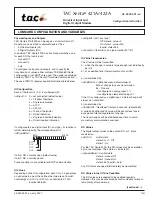
Table of Contents
1 Overview
—
1
1.1
An Introduction to Audio Networking
—
2
1.2
Distributed Audio
—
2
1.3
Network Foundations
—
3
1.4
Addressing
—
3
2
AVB Networking
—
4
2.1
System Overview
—
4
2.2
What is AVB?
—
5
2.3
How Does AVB Work?
—
6
2.4
AVB Hardware Components
—
6
2.5
Overcoming Latency
—
7
2.6
Channels and Streams
—
7
2.7
Clocking
—
8
2.7.1
Wordclock
—
8
2.7.2
Precision Time Protocol (PTP)
—
9
2.7.3
Multiple Stream Reservation Protocol
(MSRP)
—
9
2.7.4
Clocking a PreSonus AVB Network
—
11
3
AVB Networking Basics
—
13
3.1
Selecting the Right Switch
—
13
3.1.1
PreSonus SW5E AVB Switch
with PoE
—
13
3.2
Adding a Wireless Router
—
15
3.3
Choosing the Right Cables
—
16
3.3.1
Cat5e and Cat6
—
16
3.3.2
Shielded vs. Unshielded
—
17
3.3.3
Solid-core vs. Stranded
—
18
3.3.4
Plug Termination
—
19
3.3.5
T568A or T568B
—
19
3.3.6
Twisted Pair Tips
—
19
3.4
Understanding Hops
—
20
3.5
Network Topologies
—
21
3.5.1
Point-to-Point (P2P)
—
21
3.5.2
Daisy-Chain
—
22
3.5.3
Star
—
23
4
Configuring Your AVB
Network
—
24
4.1
Using AVB with a StudioLive Series III Mixer and a
Mac
—
24
4.1.1
What You Will Need
—
24
4.1.2
Making the Connections
—
24
4.1.3
Setting Up Your Mac
—
25
4.2
NSB-series Stage Box with a StudioLive Series III
Console Mixer
—
26
4.2.1
Step 1: Connect Your Stage Box
to Your Mixer
—
26
4.2.2.
Step 2: Routing Stage Box Inputs
to Mixer
—
28
4.2.3
Step 3: Engage Network Sources
—
28
4.3
NSB-series Stage Box UC Surface Setup
—
29
4.3.1
Step 1: Connect Your Stage Box
to Your Mixer
—
29
4.3.2
Step 2: Routing Stage Box Inputs
to Your Mixer
—
30
4.3.3
Step 3: Engage Network Sources
—
30
4.4
EarMix 16M with StudioLive
Console Mixers
—
31
4.5
EarMix 16M Setup from UC Surface
—
32
5
Large Network:
Real-world Example
—
34
5.1
Example Network Overview
—
34
5.2
Network Connections
—
37
5.2.1
Connecting Your Mixers
—
39
5.2.2
Connect Your NSB-series Stage Boxes
to Your Console Mixers
—
41


































